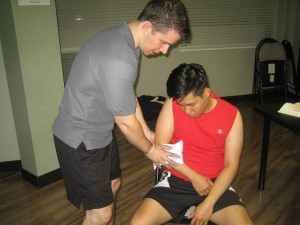The usage of cold compress or hot compress is a critical step for promoting healing, typically used based on acute injuries or chronic conditions, respectively.

Many people are often confused as to when to use hot compresses or cold compresses in injuries or conditions. Hot compress and cold compress are amongst the most commonly used treatments in the field of first aid. When used at the appropriate situation, compresses can help promote healing. Typically, cold compresses are used on acute (short-term) injuries, whereas hot compresses are used for chronic (long-term) conditions.
In cases of acute injuries, immediately after the injury, it is advised to apply a cold compress to constrict the vessels. Consequently, fluids flow to the area slower than normal, thus decreasing inflammation. Subsequently, a few days after the injury, when the initial swelling has reduced, applying hot compress can promote healing by increasing blood flow to the area, which will bring more nutrients, and platelets, among others to help the injury and prevent infection. Hot compresses are also used for treating chronic conditions.
When to Use: Cold Compress vs. Hot Compress
It is generally recommended that cold compresses be used to relieve pain by numbing the affected area. Cold compresses are also used to limit swelling and inflammation, and reduce bleeding. On the other hand, hot compresses are generally recommended to decrease joint stiffness and muscle spasm. Additionally, they are also used to help resolve inflammation and bring more to the area where it is applied. The following are specific situations as when is the proper usage of cold compress vs. hot compress:
Cold compress
- Immediately after acute conditions, such as knee pain after a long walk
- Immediately after a sprain, swelling or bruising, such as tendonitis
- Any bleeding wound, including gum and nose bleeding
- Insect Bites
- For eye bags
Hot compress
- Arthritis and other long-standing joint aches and pains
- Muscle pain
- Stomach pain, including menstrual pain
- Two to four days after an acute injury, such as a sprain, fracture, etc.
- Haemorrhoids
- Boil
- Sty
Types and Preparation: Cold Compress vs. Hot Compress
There are several different types of cold and hot compresses and there are different ways to prepare these compresses, which can include:
Cold compress
1. Ice towel
- Dampen a towel with cold water.
- Fold the towel and place inside a plastic, sealable bag
- Place the bag inside the freezer for at least 15 minutes.
- Remove from the freezer and place on the affected area.
2. Ice pack
- Place ice in a plastic, sealable bag.
- Partially fill with water.
- Seal the bag, ensuring the air is squeezed out of it.
- Wrap the bag in a damp towel and apply to the affected area.
Hot compress
1. Warm towel
- Dampen a towel with warm water. Do not use boiling water as this may cause more damage.
- Apply to the affected area.
2. Heating pad
- Heat the heating pad by soaking in warm water.
- Avoid direct contact between the heating pad device and the skin to avoid burns.
How to Do It: Cold Compress vs. Hot Compress
There is a particular method of applying cold compresses and hot
compresses to an injury. To apply the compress to an injury:
Cold compress
- Immediately after the injury, apply the cold compress to the affected area.
- Apply for 15-20 minutes every two to three hours.
- Do not fall asleep with a cold compress on the affected area as it might cause more harm, such as frostbite.
Hot compress
- For chronic conditions, apply immediately to soothe pain.
- For pain caused by acute conditions, apply two to four days after the injury. Apply for 15-20 minutes every two to three hours.
- Do not apply hot compress while sleeping.
Disclaimer: This articles seeks to provide information on which
compress would best work for minor ailments but should not be used for medical advice. Enrol in First Aid Courses to learn more about hot compress and cold compress and which should be used appropriately.
